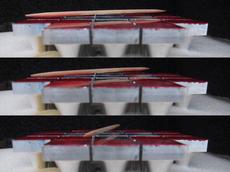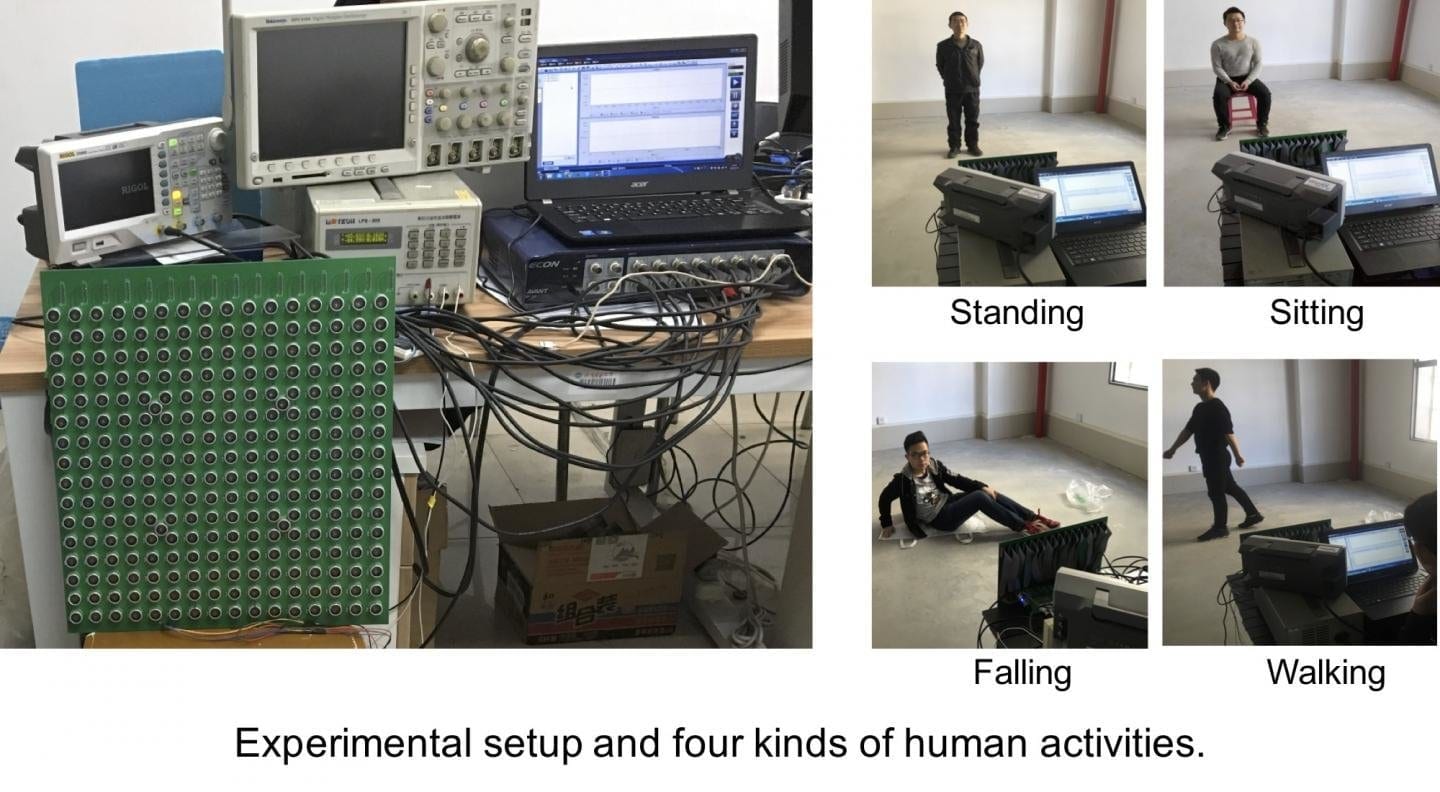
ETH researchers are able to make objects such as particles and liquid droplets fly in mid-air by letting them ride on acoustic waves.
For the first time, they have been able to also control the movement of objects, merge droplets, letting them react chemically or biologically and even rotate a toothpick in the air.
A toothpick floating in mid-air without any support – this may sound like it involves hidden threads, magnets or other sleight-of-hand tricks from magicians. But the actual trick used by Daniele Foresti, former doctoral student now a postdoctoral researcher at the Laboratory of Thermodynamics in Emerging Technologies, is based on acoustic waves. Despite the appearance of “magic”, he and his colleagues realized and controlled the planar movement of floating objects in air, regardless of their properties, involving no sorcery but science. This is not simply an amusing trick: moving objects such as particles or droplets of a liquid freely in mid-air makes it possible to investigate processes while avoiding any disruptive contact with a surface. For instance, some chemical reactions and biological processes are compromised by surfaces, and certain substances disintegrate on contact with a surface.
Riding a stationary wave
Until now, scientists have been able to generate such a “contact-free” levitational state only with the help of magnets, electrical fields or in liquids with the help of buoyancy. These methods, however, limit the selection of materials that can be handled. “It is extremely difficult to levitate and precisely move a drop of liquid with a magnet. The fluid has to possess magnetic properties. In liquids, where buoyancy force supports levitation, you can only use immiscible liquids such as a drop of oil in water,” explains Dimos Poulikakos, Professor of Thermodynamics and head of the research project.
With acoustic waves, in contrast, it is possible to levitate various objects regardless of their properties. The limiting factor is the maximum diameter of the object, which must correspond to half the wavelength of the acoustic wave being used. An object reaches the stationary levitated state when all the forces acting on it are in equilibrium. In other words, the force of gravity that pulls the object in one direction is counteracted by an equally large force in the opposite direction. This force comes from the acoustic wave, which the researchers generate as a standing wave between an emitter and a reflector that reverberates the acoustic waves. The force of the acoustic wave pushes against the object and thus prevents it from falling due to gravity. It is conceptually similar to the air jet from a fan that keeps a ping-pong ball in the air.
The Latest Bing News on:
Acoustic waves
- Blasting coffee grounds with ultrasonic waves creates a 60-second cold brewon May 8, 2024 at 8:21 am
Traditional cold brew coffee can take as long as 24 hours to properly prepare. Chemical engineers didn’t feel like waiting around that long.
- Through Sound, Scientists Transform Espresso Machine Into Quick Cold Breweron May 8, 2024 at 5:57 am
Researchers in Australia say they have successfully converted a home espresso machine into a sonic reactor for cold brew.
- Unprecedented Sound Waves – New Metamaterial Redefines Wave Amplificationon May 7, 2024 at 7:56 pm
Researchers at AMOLF, working alongside colleagues from Germany, Switzerland, and Austria, have realized a new type of metamaterial through which sound waves flow in an unprecedented fashion. It ...
- Researchers Develop 'Hair-Thin' Fabric that Effectively Suppresses Soundon May 7, 2024 at 5:00 pm
In one, the vibrating fabric generates sound waves that interfere with an unwanted noise to cancel it out, similar to noise-canceling headphones, which work well in a small space like your ears but do ...
- Researchers engineer sound-suppressing silk to reduce noise transmission in a large roomon May 7, 2024 at 6:11 am
We are living in a very noisy world. From the hum of traffic outside your window to the next-door neighbor's blaring TV to sounds from a co-worker's cubicle, unwanted noise remains a resounding ...
- Sound waves cut cold brew coffee-making time from 24 hours to 3 minson May 7, 2024 at 5:08 am
R esearchers at the University of New South Wales have developed a method using sound waves to make a cold brew coffee in mere a few minutes. They have developed an ultrasonic machine to speed up the ...
- T Bone Burnett Taps Into a River of Love for His First Acoustic Album in Decades: ‘In a Way It Feels Like My First Solo Record, at All’on May 6, 2024 at 2:48 pm
T Bone Burnett talks about 'The Other Side,' his first true new solo effort in 18 years, along with production work, like a record with Ringo Starr.
- Sound waves of wellness: Embracing relaxation at Wellspring Health Centeron May 5, 2024 at 11:51 am
At Wellspring Health Center, Kristen Wertenberger's sound bath sessions offer a meditative journey, blending resonant tones with a holistic wellness approach.
- What do cicadas sound like? These noisy insects might be in your state this yearon May 4, 2024 at 4:02 am
Male abdomens are almost completely hollow, and when sound waves from tymbals enter the hollow area, the bounce around, which can make the sound loud. Tymbals are a thin, ridged drum-like structure of ...
- sound waveson April 28, 2024 at 5:00 pm
NASA astronaut [Don Pettit] shared a short video from an experiment he performed on the ISS back in 2012, demonstrating the effects of sound waves on water in space. Specifically, seeing what ...
The Latest Google Headlines on:
Acoustic waves
[google_news title=”” keyword=”acoustic waves” num_posts=”10″ blurb_length=”0″ show_thumb=”left”]
The Latest Bing News on:
Floating objects in air
- TSB says fatal floatplane crash near Tofino caused by unexpected wake or objecton May 8, 2024 at 5:06 pm
A floatplane that crashed near Tahsis last year likely hit an unexpected boat wake or an object while landing that caused it to bounce off the ocean and crash into nearby trees, according to the ...
- Admission that Biden administration paused bomb transfers to Israel sparks outrage among Israel backers in Congresson May 8, 2024 at 2:04 pm
The reports first appeared over the weekend, when Axios quoted Israeli officials as saying that the United States had put on hold a shipment of ammunition to Israel. The Biden administration refused ...
- Floatplane hit boat wake or object before crash off Tahsis Inlet, says TSB reporton May 8, 2024 at 1:30 pm
The contact caused the plane to bounce 30 feet in the air, prompting the pilot to do a “go-around” where it struck the side of a mountain, killing the pilot and one passenger ...
- Apple Event Live Blog: New iPad Pro, iPad Air, and Moreon May 7, 2024 at 6:34 am
Apple's "Let Loose" event kicks off today at the unusual time of 7:00 a.m. Pacific Time, and we're expecting to see an ...
- Coast Guard assessing unidentified floating object in Patuakhali canalon April 28, 2024 at 9:56 am
A torpedo-like object has been spotted floating in a canal at Moudubi of Rangabali upazila in Patuakhali. Locals spotted the object in the Bhangar canal near Jahajmara beach on Sunday morning.
- Vegas Family Says Paranormal Events Have Occurred Since 10 Foot Aliens Appeared In Their Backyardon April 26, 2024 at 6:57 am
A family in Las Vegas who claimed last year that 10 foot tall aliens had crashed and were walking around in their backyard are not only sticking to their ...
- UFO watchers claim to have spotted mysterious floating orb above Joe Biden's Air Force 1on December 22, 2023 at 1:01 pm
Footage shows a floating object above the plane in Los Angeles during Biden's December 10. Multiple witnesses spotted the white or silver object over LAX airport. People have disputed what the ...
- Bizarre video of plane floating in mid-air is a creepy 'glitch in the Matrix' illusionon October 24, 2023 at 9:09 am
A video of a plane ‘floating in mid-air’ has left people on social media ... which is when the position of an object appears to differ when viewed from different angles. Both planes are ...
- Flying ‘Octagon’ Shot Down Near U.S.-Canada Border On Sundayon February 12, 2023 at 1:02 pm
“The object has been downed by pilots from the U.S. Air Force and National Guard ... that started this new national obsession with floating balloons was actually just for monitoring weather ...
- Lesson 5.1 - Engineering a Floatation Deviceon December 25, 2022 at 9:31 pm
Students will design, test, modify, and optimize a device that uses a chemical reaction to produce enough gas to inflate a bag to make a cell phone float. The goal of engineering is to design an ...
The Latest Google Headlines on:
Floating objects in air
[google_news title=”” keyword=”floating objects in air” num_posts=”10″ blurb_length=”0″ show_thumb=”left”]











